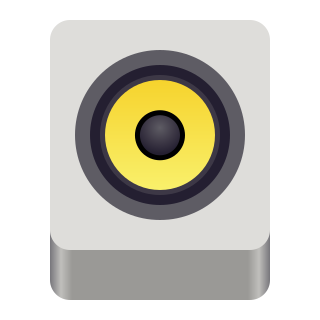
A digital music store is a business that sells digital audio files of music recordings over the Internet. Customers gain ownership of a license to use the files, in contrast to a music streaming service, where they listen to recordings without gaining ownership. Customers pay either for each recording or on a subscription basis. Online music stores generally also offer partial streaming previews of songs, with some songs even available for full length listening. They typically show a picture of the album art or of the performer or band for each song. Some online music stores also sell recorded speech files, such as podcasts, and video files of movies.

RealPlayer, formerly RealAudio Player, RealOne Player and RealPlayer G2, is a cross-platform media player app, developed by RealNetworks. The media player is compatible with numerous container file formats of the multimedia realm, including MP3, MP4, QuickTime File Format, Windows Media format, and the proprietary RealAudio and RealVideo formats. RealPlayer is also available for other operating systems; Linux, Unix, Palm OS, Windows Mobile, and Symbian versions have been released.

Rhythmbox is a free and open-source audio player software, tag editor and music organizer for digital audio files on Linux and Unix-like systems.
M3U is a computer file format for a multimedia playlist. One common use of the M3U file format is creating a single-entry playlist file pointing to a stream on the Internet. The created file provides easy access to that stream and is often used in downloads from a website, for emailing, and for listening to Internet radio.

Audible is an American online audiobook and podcast service that allows users to purchase and stream audiobooks and other forms of spoken word content. This content can be purchased individually or under a subscription model where the user receives "credits" that can be redeemed for content monthly and receive access to a curated on-demand library of content. Audible is the United States' largest audiobook producer and retailer. The service is owned by Audible, a wholly-owned subsidiary of Amazon.com, Inc., headquartered in Newark, New Jersey.

An Internet radio device, also called network music player is a hardware device that is capable of receiving and playing streamed media from either Internet radio stations or a home network.
The Motorola ROKR, the first version of which was informally known as the iTunes phone, was a series of mobile phones from Motorola, part of a 4LTR line developed before the spin out of Motorola Mobility. ROKR models were released starting in September 2005 and ending in 2009. They were notable for incorporating support of media player features.

SoundBridge is a hardware device from Roku, Inc. designed to play internet radio or digital audio streamed across a home network, over either Wi-Fi or ethernet. SoundBridge devices directly browsed the Radio Roku guide. As of 2008 all Roku SoundBridge products were discontinued; Roku focused on IPTV. As of January 2012, the SoundBridge was no longer available from Roku. As of May 2018, internet radio functionality was no longer supported by Roku the shut down their Radio Roku server that provided searching, saving and accessing "Favorite" stations. However, the Roku SoundBridge can still access radio streams stored in its 18 URL presets.

Banshee was a cross-platform open-source media player, called Sonance until 2005. Built upon Mono and Gtk#, it used the GStreamer multimedia platform for encoding, and decoding various media formats, including Ogg Vorbis, MP3 and FLAC. Banshee can play and import audio CDs and supports many portable media players, including Apple's iPod, Android devices and Creative's ZEN players. Other features include Last.fm integration, album artwork fetching, smart playlists and podcast support. Banshee is released under the terms of the MIT License. Stable versions are available for many Linux distributions, as well as a beta preview for OS X and an alpha preview for Windows.
D-STAR is a digital voice and data protocol specification for amateur radio. The system was developed in the late 1990s by the Japan Amateur Radio League and uses minimum-shift keying in its packet-based standard. There are other digital modes that have been adapted for use by amateurs, but D-STAR was the first that was designed specifically for amateur radio.
Digital music stores sell copies of digital audio, for example in MP3 and WAV file formats. Unlike music streaming services, which typically charge a monthly subscription fee to stream digital audio, digital music stores download songs to the customer's hard disk drive of their device. The customer will have the copy of the song permanently on their disk, provided the track is not deleted by the customer, the disk does not get physically damaged, or suffers from being corrupted. Major examples of digital music stores include iTunes Store, Amazon Music, Bandcamp and 7digital.
Spotify is a Swedish audio streaming and media services provider founded on 23 April 2006 by Daniel Ek and Martin Lorentzon. It is one of the largest music streaming service providers, with over 551 million monthly active users, including 220 million paying subscribers, as of June 2023. Spotify is listed on the New York Stock Exchange in the form of American depositary receipts.

Online radio is a digital audio service transmitted via the Internet. Broadcasting on the Internet is usually referred to as webcasting since it is not transmitted broadly through wireless means. It can either be used as a stand-alone device running through the Internet, or as a software running through a single computer.

RealNetworks, Inc. is a provider of artificial intelligence and computer vision based products. RealNetworks was a pioneer in Internet streaming software and services. They are based in Seattle, Washington, United States. The company also provides subscription-based online entertainment services and mobile entertainment and messaging services.

AIMP is a freeware audio player for Windows, Android and Linux, originally developed by Russian developer Artem Izmaylov. It supports a variety of audio codecs, and includes tools to convert audio files and edit their metadata, as well as the capability of installing user-made skins and plugins.
The following is a list of on-demand music streaming services. These services offer streaming of full-length content via the Internet as a part of their service, without the listener necessarily having to purchase a file for download. This type of service is somewhat similar to Internet radio. Many of these sites have advertising and offer non-free options in the style of a digital music store.

myTuner Radio, or simply myTuner, is an Internet radio app directory/platform owned by AppGeneration – Software Technologies, Lda, a development company based in Porto, Portugal founded by Eduardo Carqueja in October 2010. myTuner Radio has over 50,000 radio stations and one million podcasts from all around the world. On June 7, 2017, AppGeneration announced that its service had over 30 million users and a database with radio stations of 200 countries. my Turner Radio platform is available for the web at mytuner-radio.com, for a suite of mobile apps: iOS, Google Play, Samsung, Huawei, Amazon, Windows Phone; for desktop devices: Web, Windows, and Mac, wearables: Apple Watch and Android Wearables, for connected devices like Apple TV, Samsung TVs, LG TVs, TV sets and set-top boxes with Android TV, Amazon Fire TV, Roku TV and Chromecast, connected cars: Apple Carplay, Android Auto, Bosch mySPIN, Jaguar & Land Rover InControl Apps, and also on home appliances and smart speakers like Alexa and Sonos.
The second decade of the 21st century has continued to usher in new technologies and devices built on the technological foundation established in the previous decade. Technologically speaking, our personal devices and lives have evolved symbiotically, with the personal computer at the center of our daily communications, entertainment, and education. What has changed is accessibility and versatility; users can now perform the same functions and activities of their personal computer on a wide range of devices: smartphones, tablets, and even more recently, smart watches. The increase in personal computing capacity has a profound impact on the way people listen to, promote, and create music.











